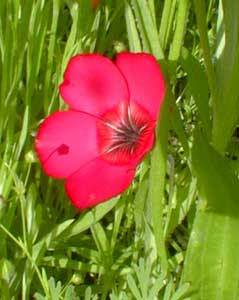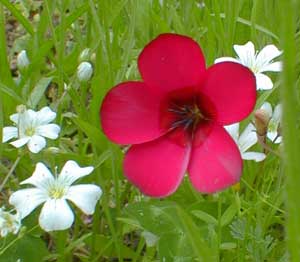
Scarlet Flax
"Fire is bright,
Let temple burn, or flax."
Elizabeth Barrett Browning
(1806‚1861)
"For I was flax, & He was flames of fire:
Our firm-united souls did more than twine."
-Francis Quarles
(1592‚1644)
(1806‚1861)
(1592‚1644)
In our zone the ultra-hardy annual Scarlet Flax (Linum grandiflorum var rubrum, formerly L. coccineum), when spring-sewn, blooms in April or May. If seeds are dispersed every three weeks for two months, the reddest-of-red flowers will persist until first frost. It may even self-seed on its own to persist until about September. Each solitary scarlet bloom only lasts about a day, but new blooms are produced serially for a continuous presence amidst foliage only a foot or so high.
Heat & drought tolerant to a high degree, & desirous of full sun, it nevertheless has its heat limits & will want a bit of watering at the height of summer . Seedlings need moderate watering to get started, although for us, our spring rainfalls are usually sufficient.
 In the south it is planted in autumn, but in our zone it is surface-sewn at winter's end, or early spring, whenever threat of frost has passed. When sewn, a scant one-eighth inch of soil tamped over the seeds will keep them from being eaten by insects or birds.
In the south it is planted in autumn, but in our zone it is surface-sewn at winter's end, or early spring, whenever threat of frost has passed. When sewn, a scant one-eighth inch of soil tamped over the seeds will keep them from being eaten by insects or birds.Native of the Mediterranean region in southern Europe & northern Africa. Widely available in wildflower seed mixes or separately, packets of seeds being perfect annuals for roadside meadow planting. It can be grown anywhere in the United States, & has naturalized in many states where winters are warm.
The seeds glisten because of their high oil content, flax being the source of linseed oil with which linoleum is manufactured, & artists' paints, with scores of industrial uses. L. usitatissum is the species grown commercially for linseed oil, but it can also be obtainted from L. grandiflorum & other flaxes.
In Africa, the seeds are roasted & added to baked bread, & is thought to have medicinal properties. It is not eaten in the west, but the meal that remains after oil extraction is used as a livestock feed.
In ancient Rome, flax symbolized the Sun-god Mithra.
In Egypt, both blue & scarlet flax symbolized the fire of the Sun God Ra, & was sacred to Isis who taught humanity the many uses of the genus for oil, food, medicine, & linen. Scarlet flax indicated virility of men, & women's fertility, while blue flax was sacred wisdom, a "flax warrior" being even today, in India, synonymous with priesthood.